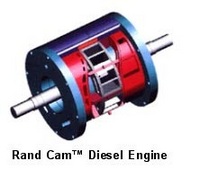Compression Tests Successful On RadMax™ 375 HP Diesel Engine
 |
Prototype Support
- Assembly and Testing of the Diesel Prototype is the focus of efforts at
Williams and White.
- The engine was assembled with half of the vanes and cam followers installed.
- One set of vanes were positioned to allow the installation of all seals and form a single combustion chamber.
- A hydrostatic pressure test was performed first at 400 psi, then 800 psi, and 1,000 psi.
- Main bearing function test was performed.
- Engine binding and alignment tests were performed.
- Additional friction data was obtained.
- Pressure Test Data:
- A single combustion chamber was tested to verify pressure containment. A new standard diesel engine would show about 400 psi on a standard compression test. The combustion chamber was pressurized to 400 psi with very little pressure bleed off. The chamber pressure was increased to double the required psi, 800 psi and again little pressure bleed off was observed. The chamber pressure was again increased to 1,000 psi and was observed for 5 minutes and the pressure drop was less than 100 psi. This indicates that the engine will be able to combust diesel, natural gas, regular gasoline, methanol and other currently used fuels.
- Friction and Binding Data:
- The friction with the current arrangement was measured at about 200 ft. lbs. Binding of the components was drastically reduced with the new main bearing spacers in place. The engine was able to be rotated by hand with minimal binding. The cam follower system functioned as designed. It was observed that the force required to rotate the engine increased as the combustion chamber approached TDC. (Top Dead Center) This would indicate that pressure was being built by the engine. It was also observed that the friction of the engine reduced with successive revolutions. This would indicate that the minimal lubrication was helping to "wear in" the tight components and reduce the overall friction.
Plans
- The original design included static style vane seals in order to establish, cost effectively, that the sealing approach on the combustion chamber was correct. In order to move forward with this prototype, a number of seal configurations must be tested to find the optimal design that will seal the chamber with the least friction. Therefore a small seal test fixture will be designed and various types of seals will be tested.
- The wheel used to follow the cam on the stator are currently free floating on the spindle and spacers will be designed and tested to improve tracking of the wheels and reduce the chance of binding or pinching.
- The above steps will allow further testing of the engine, which will include pre ignition friction and compression tests, low, medium and high speed rotation tests followed by combustion tests. During the combustion testing we will be able to capture net horsepower, efficiency and emissions data for various rpms and power settings.
John Robertson, President of Reg Technologies Inc. and REGI U.S., Inc., states, "The Compression tests now confirm that combustion for the diesel fuel will be attainable and the sealing is sufficient to retain the compression:"


